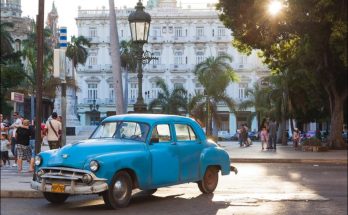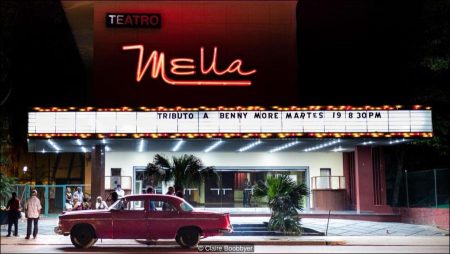
In the 1950s, Havana was aglow with thousands of neon signs. Now, one man has made it his mission to shine a light on the Cuban capital’s vintage past.
In the mid-1900s, Havana twinkled with thousands of technicolour tubes of neon. The city’s glitterati flocked to grand theatres glowing with multi-coloured facades. Bars thrumming with jukebox tunes beckoned Habaneros inside with flashing signs. And on the city streets, the seductive curves and chrome of American-made cars glinted in the neon-lit night. Havana was a city shining in decadence, culture and art.
But following Fidel Castro’s 1959 revolution, government regulations and different economic priorities forced many of Havana’s swanky venues to shutter, leaving their neon signs to go black with them. Decades of economic turmoil and tight trade restrictions under the US embargo have made it difficult to repair these rusted relics, and Havana’s once-bright signs have all but faded from memory.
Now, more than half a century later, a Cuban artist is switching the city’s vintage neon tubes back on and relighting Havana’s streetscapes for the city’s 500th birthday in 2019. During the past three years, artist Kadir López has been painstakingly rescuing and restoring the city’s vintage signs one by one as part of his Habana Light Neon + Signs project. So far, he and his team have resurrected more than 50 signs to their former glory. And, nearly 40 years after it closed, López re-opened Havana’s famous Rex Cinema in April as the new REX Neon Center.
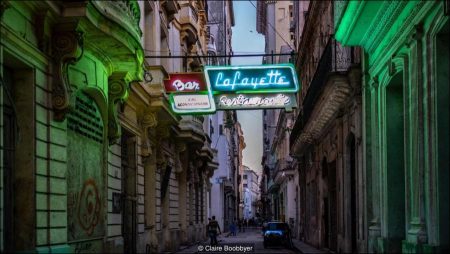
“Neon has illuminated the dark and allowed people to see what they didn’t see before,” López told me as we sat in the REX. “The effect of neon is phenomenal. People are looking at the city in a different way. With a little bit of light, locals can see the city’s wrinkles and the light of history.”
From the 1930s to 1950s, when bars, boudoirs and burlesque lured the mafia, the rich and the libertine to Cuba, Havana was ablaze with neon signs advertising bawdy theatre, sequinned showgirls, Golden Age celluloid, restaurants and other businesses. Havana had its own Broadway – named Calle 23 – and more than 140 cinemas (more than New York and Paris had at the time), all gleaming with neon.
In the 1960s, after the Communist Cuban Revolution closed and nationalised corporate American businesses, Castro’s new government invested in ballet, art, theatre and film, but not in the city’s ageing streets and architecture. Havana’s high-voltage signs were torn down or left to wither in situ like dead fireflies.
But thanks to the state’s increased legalisation of private businesses, property sales and foreign investment within the last decade, a growing number of Havana entrepreneurs have begun commissioning neon signs for their new businesses. This newfound commercial interest, coupled with financing from international sponsors for individual signs, has led López’s restoration project to slowly begin re-lighting the once-bright neon signs adorning state-run theatres, cinemas and restaurants that had gone dark in recent decades.
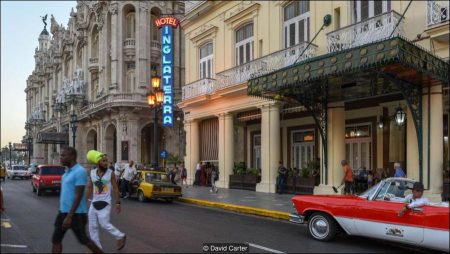
López woos potential sponsors with the line “These are abandoned creatures [that] need adopting”. Restoring these neon relics is a painstaking process. Once López and his team receive a commission, they set up scaffolding to carefully remove and lower the old sign with rope. They then place it in the back of a pickup truck, drive it back to López’s workshop in the Kohly neighbourhood and begin slowly removing any rust before heating the tubes to bend the letters perfectly back into place. Restoring one sign may take between two or three weeks, depending on the condition of the sign and the complexity of each design. Once the sign is repaired, they’ll drive it back and resurrect it in its original location.
Like delicate filigree, López’s bright signs are also helping to shine a light on Havana’s wealth of Baroque, Art Deco and Spanish colonial facades. His team is currently restoring the gloriously curlicue Fin de Siglo sign on the eponymous department store on Galiano Street, signs for the San Rafael Boulevard and the entire neon constellation at the city’s famous Tropicana Cabaret. In the past three years, López and his team have restored sparkling tubes for Central Park’s Hotel Inglaterra, the Cine El Mégano theatre and the storied Mella Theatre. Some 150 additional neon signs have been commissioned for restoration.
López grew up in Havana, whose streets were littered with rusted and burnt-out signs, but it wasn’t until 10 years ago that he became interested in using old signage in his art work – a journey that eventually led him to neon. López began salvaging American petrol station signs from Havana backyards and layering them with 1950s archival photographs. He also began sifting through old maps, albums, letters and discarded signs around Cuba. Some of these signs sported the tell-tale puncture holes of neon tubes. López then took pictures of Havana theatre and cinema facades and translated these snapshots into oil on large-scale canvases for a series displayed during the 2012 Havana Biennial.
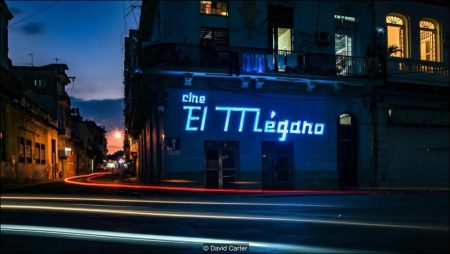
López continued to be intrigued by the puncture holes after the 2012 exhibition, and began thinking about incorporating neon into his art. “My training had all been classic, in the durability of art, so I found it hard to define neon as art,” he said. “The light of the neon – a gas in a tube that can’t escape – is akin to putting something in jail where it dies. But then I thought, that same light, the neon, gives a chance to illuminate and make change.”
In a country that produces very little, forcing thousands to go bulk shopping in Miami and Panama for everything from spare tools to paint, López wondered how he could make neon with limited materials. But his light-bulb moment came when he tracked down two Cuban glass workers and began repairing existing tubes using old tools discovered in Havana. A fortuitous meeting with Cuban-American neon sign restorer Adolfo Nodal and an introduction to Jeff Friedman of New York’s Let There Be Neon studio forged the perfect fit. With Nodal’s background and Friedman’s expertise, logistics and donated supplies, López’s Habana Light Neon + Signs project was born.
López converted his backyard in Havana into a workshop. It soon took on the appearance of an unkempt graveyard with signs, wires and jumbled neon. He was at the point of quitting when he learned that Cuba’s first multiplex theatre, the 1938-built Rex Cinema, could be rented from the government. Undeterred by decades of stacked sewage inside the abandoned 650-sq-m space, López and a team of construction workers began restoring the Rex and the adjacent former Cine Duplex, transforming the two into the new multipurpose REX Neon Center.
In addition to housing a dazzling display of restored signs, the newly opened centre features displays about Havana’s neon heritage and an array of old neon lights. The former Cine Duplex will feature a lecture space, a theatre to screen films about art and a gallery featuring the work of Cuban artists. A production centre with an in-house glass worker is set to open in the future. The hope, according to López and Nodal, is to interest young Cubans in neon light work.
Nodal’s backstory could not be more perfect to help spark Havana’s neon revolution. He spent 25 years restoring 300 signs in Los Angeles, driving the streets “like the neon police,” he said. These days, when Nodal is in Havana working on the project with López, he spends his time sifting the streets in search of forlorn dangling signs. “We want to protect them now as people will take them down,” he said.
“The ultimate goal is to bring back a sense of light in the public realm,” Nodal said. “It’s great to see an artist changing the way a city looks.”
I left the REX, walking past the blinking scarlet-red Cinecito sign towards the ice-blue letters signalling the Inglaterra and set up my camera to capture these treasures glowing in the dusk. The street was thronged with tourists and locals, and as they strolled under the neon signs fronting the city’s theatres, cinemas and cocktail bars, Havana never seemed to shine brighter.
Visits: 129


